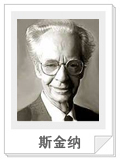斯金纳(B. F. Skinner)
——行为主义心理学家
——行为主义心理学家

1904年,斯金纳生于宾夕法尼亚州的一个小镇上,父亲是当地的律师,他从小就爱制作各种小玩艺,成为行为主义心理学家后,又发明并改造了很多动物实验的装置。在中学和大学期间,他曾立志当一名作家,并曾获得希腊文特别奖,他曾经试图进行文学创作,但很快,他就发现无论是自己还是其他作家对人的行为的理解都少得可怜,为了更深入的理解人的行为,他转向了心理学。
在哈佛大学攻读心理学硕士的时候,他受到了行为主义心理学的吸引,成为了一名彻头彻尾的行为主义者,从此开始了他一生的心理学家生涯。他在华生等人的基础上向前迈进了一大步,提出了有别于巴甫洛夫的条件反射的另一种条件反射行为,并将二者做了区分,在此基础上提出了自己的行为主义理论――操作性条件反射理论。他长期致力于研究鸽子和老鼠的操作性条件反射行为,提出了“及时强化”的概念以及强化的时间规律,形成了自己的一套理论。
斯金纳还将操作性条件反射理论应用于对人的研究,他认为,人是没有尊严和自由的,人们做出某种行为,不做出某种行为,只取决于一个影响因素,那就是行为的后果。人并不能自由选择自己的行为,而是根据奖惩来决定自己以何种方式行动,因此,人既没有选择自己行为的自由,也没有任何的尊严,人和动物没有什么两样。 斯金纳还将自己的强化理论推广到教育心理学领域,他提出了一种新型的教育模式,并研制设计出了新型的教学机器。在他的领导之下,新教材开始编制,教学机器也在各大中学校广为应用,一时间在教育界掀起了一场轰轰烈烈的程序教学运动。斯金纳在各个领域推销他的操作性条件反射理论,在心理治疗领域,他提出了塑造行为的行为矫正技术,不断地利用奖惩来塑造人们的行为,促使人们做出好的行为,改变不良行为。现在行为主义学派的行为矫正技术仍然在心理治疗领域广为应用。
斯金纳还提出了自己对理想社会的设想,在其名著《沃尔登第二》一书中,他描述了一个理想的乌托邦似的社会,在这个社会中,孩子从诞生之日起,就通过强化来进行严格的行为形成训练,孩子们要被训练成具有合作精神和社交能力的人,所有的训练都是为了社会全体成员的利益和幸福。这本书在美国极受推崇,大学生们尤其热衷于阅读此书,在美国弗吉尼亚州,甚至还有人真正根据《沃尔登第二》的模式建立起了一个公社。 斯金纳在美国公众中的名声远比在心理学界的名声大得多,一位崇拜者写道:“(斯金纳)是一个神话中的著名人物......科学家英雄,普洛米休斯式的播火者,技艺高超的技术专家......敢于打破偶像的人,不畏权威的人,他解放了我们的思想,从而脱离了古代的局限。”这些话虽然有些夸张,但斯金纳在心理学界的贡献仍然是不可磨灭的。
斯金纳的主要著作有: 《有机体的行为》 (1938)、 《科学和人类行为》(1953)、《言语行为》(1957)、《强化程序》(1957)、《教学技术》(1968)、 《关于行为主义》(1974)、 《超越自由和尊严》(1971)等。
在哈佛大学攻读心理学硕士的时候,他受到了行为主义心理学的吸引,成为了一名彻头彻尾的行为主义者,从此开始了他一生的心理学家生涯。他在华生等人的基础上向前迈进了一大步,提出了有别于巴甫洛夫的条件反射的另一种条件反射行为,并将二者做了区分,在此基础上提出了自己的行为主义理论――操作性条件反射理论。他长期致力于研究鸽子和老鼠的操作性条件反射行为,提出了“及时强化”的概念以及强化的时间规律,形成了自己的一套理论。
斯金纳还将操作性条件反射理论应用于对人的研究,他认为,人是没有尊严和自由的,人们做出某种行为,不做出某种行为,只取决于一个影响因素,那就是行为的后果。人并不能自由选择自己的行为,而是根据奖惩来决定自己以何种方式行动,因此,人既没有选择自己行为的自由,也没有任何的尊严,人和动物没有什么两样。 斯金纳还将自己的强化理论推广到教育心理学领域,他提出了一种新型的教育模式,并研制设计出了新型的教学机器。在他的领导之下,新教材开始编制,教学机器也在各大中学校广为应用,一时间在教育界掀起了一场轰轰烈烈的程序教学运动。斯金纳在各个领域推销他的操作性条件反射理论,在心理治疗领域,他提出了塑造行为的行为矫正技术,不断地利用奖惩来塑造人们的行为,促使人们做出好的行为,改变不良行为。现在行为主义学派的行为矫正技术仍然在心理治疗领域广为应用。
斯金纳还提出了自己对理想社会的设想,在其名著《沃尔登第二》一书中,他描述了一个理想的乌托邦似的社会,在这个社会中,孩子从诞生之日起,就通过强化来进行严格的行为形成训练,孩子们要被训练成具有合作精神和社交能力的人,所有的训练都是为了社会全体成员的利益和幸福。这本书在美国极受推崇,大学生们尤其热衷于阅读此书,在美国弗吉尼亚州,甚至还有人真正根据《沃尔登第二》的模式建立起了一个公社。 斯金纳在美国公众中的名声远比在心理学界的名声大得多,一位崇拜者写道:“(斯金纳)是一个神话中的著名人物......科学家英雄,普洛米休斯式的播火者,技艺高超的技术专家......敢于打破偶像的人,不畏权威的人,他解放了我们的思想,从而脱离了古代的局限。”这些话虽然有些夸张,但斯金纳在心理学界的贡献仍然是不可磨灭的。
斯金纳的主要著作有: 《有机体的行为》 (1938)、 《科学和人类行为》(1953)、《言语行为》(1957)、《强化程序》(1957)、《教学技术》(1968)、 《关于行为主义》(1974)、 《超越自由和尊严》(1971)等。
Burrhus Frederic Skinner (1904-1990)